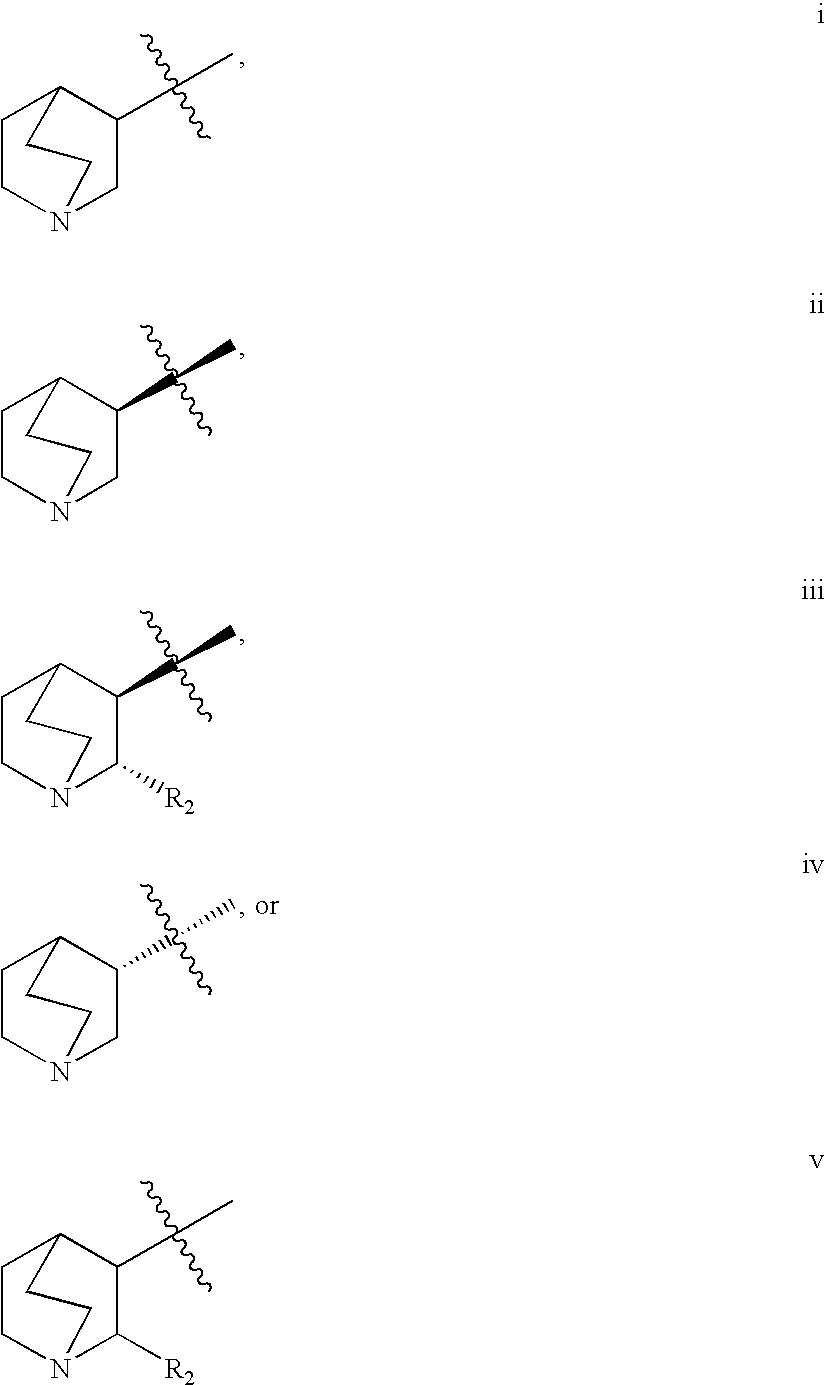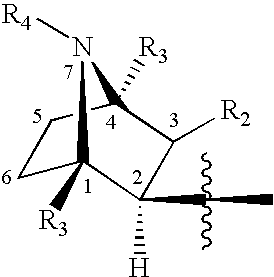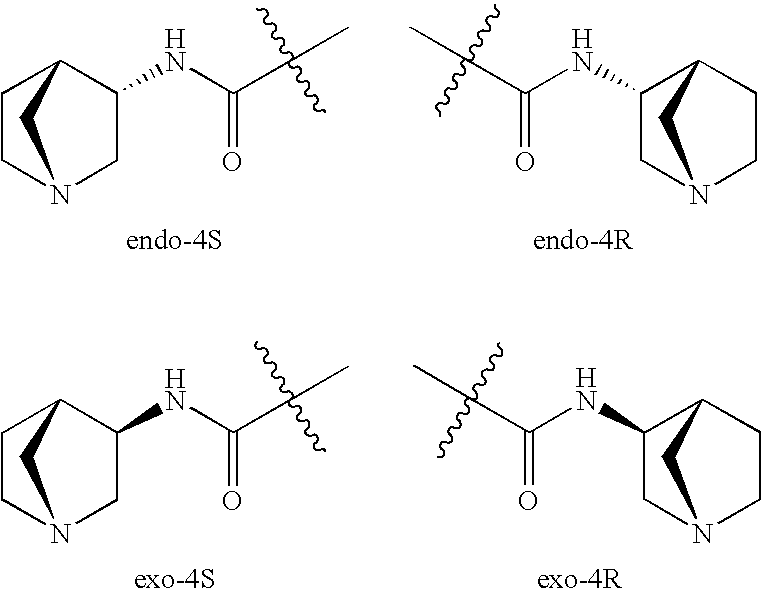Treatment of attention defecit hyperactivity disorder
a hyperactivity disorder and attention deficit technology, applied in the field of treatment, can solve the problems of adhd, children with high rates of injury, disorder has negative long-term effects on a child's ability to make friends and the child's functionality, and cannot sit still,
- Summary
- Abstract
- Description
- Claims
- Application Information
AI Technical Summary
Benefits of technology
Problems solved by technology
Method used
Image
Examples
example 1 (
EXAMPLE 1(H)
N-[(3R)-1-azabicyclo[2.2.2]oct-3-yl]-4-bromo-1H-pyrazole-1-carboxamide Hydrochloride
[0659]
[0660] A solution of 4-bromopyrazole(0.52 g, 3.5 mmol) in 30 mL EtOAc is added to excess phosgene (10 mL, 20% solution in toluene) in EtOAc. After complete addition, the solution is refluxed for 1 h, cooled and concentrated in vacuo. EtOAc is added, and the mixture is concentrated again. The residue is treated with 20 mL THF, (R)-(+)-3-aminoquinuclidine dihydrochloride (0.71 g, 3.5 mmol) and excess TEA (5.0 mL, 68.1 mmol). After 60 h, 1N NaOH solution is added. The mixture is extracted with CHCl3, dried (MgSO4), filtered and concentrated. The residue is purified by flash chromatography (Biotage 40S, 90:9:1 CHCl3 / MeOH / NH4OH). Example 1 (H) is prepared and recrystallized from MeOH / EtOAc to afford 289 mg (25%) of a white solid. HRMS (FAB) calcd for C11H15BrN4O+H 299.0508, found 299.0516.
example 2 (
EXAMPLE 2(H)
N-[(3R)-1-azabicyclo[2.2.2]oct-3-yl]-4-iodo-1H-pyrazole-1-carboxamide Hydrochloride
[0661]
[0662] Phenyl chloroformate (0.75 mL, 6.0 mmol) is added dropwise to a solution of 4-iodopyrazole (1.05 g, 5.4 mmol) and TEA (0.9 mL, 6.5 mmol) in 15 mL CH2Cl2. The reaction is stirred at RT. After 60 h, water is added. The mixture is extracted with CH2Cl2, dried (MgSO4), filtered and concentrated. Hexane is added and the solvent is removed in vacuo. A white solid forms on standing to provide 1.6 g (95%) of phenyl 4-iodo-1H-pyrazole-1-carboxylate. MS (EI) m / z 315.1 (M+).
[0663] Phenyl 4-iodo-1H-pyrazole-1-carboxylate (1.6 g, 5.2 mmol) and (R)-(+)-3-aminoquinuclidine dihydrochloride (1.0 g, 5.2 mmol) are suspended in 10 mL DMF. DIEA (2.7 mL, 15.5 mmol) is added dropwise. After 36 h, the solvent is removed and the residue is taken up in 1N NaOH and CHCl3. The aqueous layer is extracted with CHCl3, dried (MgSO4), filtered and concentrated. The residue is purified by chromatography (Bio...
example 3 (
EXAMPLE 3(H)
N-[(3R)-1-azabicyclo[2.2.2]oct-3-yl]-4-(2-chlorophenyl)-1-H-pyrazole-1-carboxamide Hydrochloride
[0664]
[0665] Hydrazine hydrate (0.55 mL, 11.3 mmol) is added to a suspension of 2-chlorophenylmalondialdehyde dissolved in 20 mL EtOH. The mixture is heated under reflux for 3 min, then allowed to stir at RT overnight. The solvent is removed in vacuo to provide 4-(2-chlorophenyl)-1H-pyrazole as a yellow solid. MS (EI) m / z 177.0 (M−).
[0666] 4-Nitrophenyl chloroformate (2.3 g, 11.5 mmol) and 4-(2-chlorophenyl)-1H-pyrazole (2.0 g, 11.0 mmol) are dissolved in 30 mL CH2Cl2 and cooled to 0° C. TEA (1.7 mL, 12.0 mmol) is added, and the reaction is allowed to warn to RT. After 30 min, additional 4-nitrophenyl chloroformate (0.25 g) and TEA are added. After 1h, water is added. The mixture is extracted with CH2Cl2, dried (MgSO4), filtered and concentrated to give a solid. The solid is triturated with hexanes, filtered and dried to provide 1.7 g (45%) of the crude 4-nitrophenyl 4-(2-ch...
PUM
| Property | Measurement | Unit |
|---|---|---|
| Therapeutic | aaaaa | aaaaa |
Abstract
Description
Claims
Application Information
 Login to View More
Login to View More - R&D
- Intellectual Property
- Life Sciences
- Materials
- Tech Scout
- Unparalleled Data Quality
- Higher Quality Content
- 60% Fewer Hallucinations
Browse by: Latest US Patents, China's latest patents, Technical Efficacy Thesaurus, Application Domain, Technology Topic, Popular Technical Reports.
© 2025 PatSnap. All rights reserved.Legal|Privacy policy|Modern Slavery Act Transparency Statement|Sitemap|About US| Contact US: help@patsnap.com



